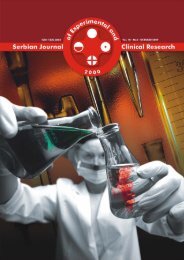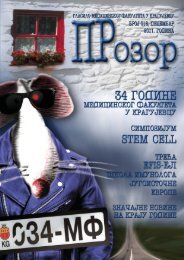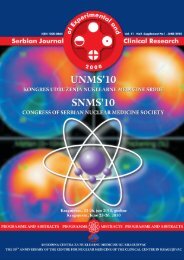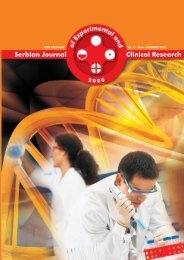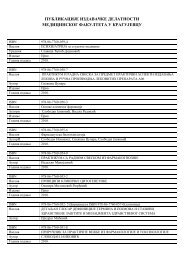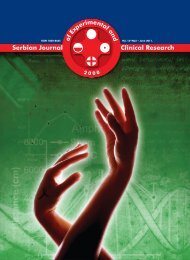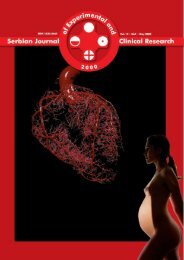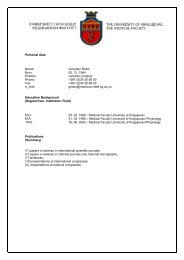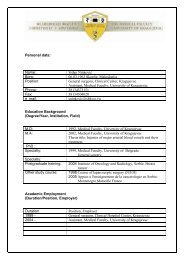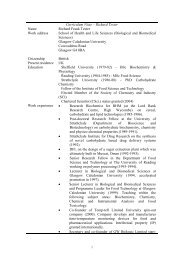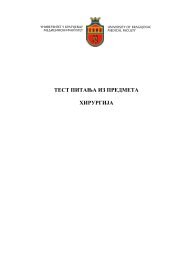neurotoxicity and mechanisms of induced hyperexcitability
neurotoxicity and mechanisms of induced hyperexcitability
neurotoxicity and mechanisms of induced hyperexcitability
You also want an ePaper? Increase the reach of your titles
YUMPU automatically turns print PDFs into web optimized ePapers that Google loves.
INTRODUCTIONSchizophrenia is a chronic <strong>and</strong> severe psychiatric disorderthat generally occurs in late adolescence or earlyadulthood. Approximately 1% <strong>of</strong> the population worldwideis affected by schizophrenia, placing a heavy burdenon society, both in terms <strong>of</strong> emotional suffering <strong>and</strong> economicloss [1]. Schizophrenia is the classic example <strong>of</strong> adisorder that always has psychosis as one <strong>of</strong> its features[2]. As psychotic episodes are extremely debilitating,management <strong>and</strong> treatment aim to reduce <strong>and</strong> eliminatethese dramatic personality changes, consisting <strong>of</strong> irritability,confusion <strong>and</strong> paranoia associated with hallucinations<strong>and</strong> delusions. Antipsychotic drugs are used to treatnearly all forms <strong>of</strong> psychosis, including schizophrenia.It has been generally accepted that the mechanism bywhich antipsychotic drugs decrease hallucinations <strong>and</strong>delusions is mediated at least in part by dopamine D 2receptorblockade [3-5]. Moreover, atypical antipsychoticdrugs, such as olanzapine, display a unique neuropharmacologicalpr<strong>of</strong>ile; they minimise psychoses by interactingwith a number <strong>of</strong> neurotransmitter <strong>and</strong> receptorsystems through binding at multiple receptor sites. Olanzapinehas a high affinity for serotonin 5 HT 2A, dopamine,cholinergic, histamine <strong>and</strong> α1-adrenergic receptors [6].However, the most important <strong>mechanisms</strong> underlyingthe clinical properties <strong>of</strong> atypical antipsychotic drugs appearto be mediated by interactions with the serotonin5-HT 2Areceptor subtype [7, 8].Serotonin is one <strong>of</strong> the major neurotransmitters in thehuman brain <strong>and</strong> plays a central role in the regulation <strong>of</strong>a wide range <strong>of</strong> behaviours, such as mood, eating <strong>and</strong> thestress response [9-11]. The serotonergic projections arisingfrom the brainstem raphe nuclei form the largest <strong>and</strong>most complex efferent system in the human brain [12, 13].The axons <strong>of</strong> dorsal raphe nucleus (DRN) neurons contributeto the majority <strong>of</strong> the serotonergic innervation in thefrontal cortex, ventral hippocampus <strong>and</strong> striatal regions[14, 15], while the axons <strong>of</strong> median raphe nucleus (MRN)serotonergic neurons are more abundant in the dorsal hippocampus<strong>and</strong> the cingulate cortex [16, 17]. The hypothalamus,the substantia nigra <strong>and</strong> the nucleus accumbensreceive serotonergic innervation from both nuclei [18, 19].This organisation <strong>of</strong> the serotonergic neuronal populationsuggests that serotonin is involved in the regulation <strong>of</strong> differentfunctional systems, such as the motor, limbic <strong>and</strong>somatosensory systems [13]. Thus, it is not surprising thatatypical antipsychotic medications target multiple brainserotonin receptor subtypes. As it is very difficult to assessalterations <strong>of</strong> serotonergic transmission in the pathophysiology<strong>of</strong> psychiatric disorders in the living human brain,animal models are needed.Animal models <strong>of</strong> psychiatric disorders, includingschizophrenia, rely on mimicking specific aspects orsymptoms associated with the disease [20-22]. The twomost widely used models are locomotor hyperactivity <strong>induced</strong>by psychotomimetic drugs <strong>and</strong> prepulse inhibition.Psychotomimetic drugs, such as amphetamine <strong>and</strong> phencyclidine,can induce abnormal behaviours in animals <strong>and</strong>mimic certain aspects <strong>of</strong> psychotic disorders in humans[20, 23-25]. Amphetamine, an indirectly acting sympathomimetic,causes increased dopamine release from presynapticterminals [26], <strong>and</strong> hyperlocomotion <strong>induced</strong> byamphetamine is dependent upon intact subcortical dopamineactivity in the nucleus accumbens [27]. In contrast,phencyclidine interferes with multiple neurotransmittersystems [28]. Phencyclidine acts as a non-competitiveantagonist at the ion channel associated with the N-methyl-D-aspartate (NMDA) glutamate receptor <strong>and</strong>also indirectly facilitates dopaminergic <strong>and</strong> serotonergictransmission [29]. Similar <strong>mechanisms</strong> are also activatedin humans by phencyclidine [30]. Prepulse inhibition <strong>of</strong>the acoustic startle response is an operational measure<strong>of</strong> sensorimotor gating that is disrupted in patients withschizophrenia [31, 32] <strong>and</strong> in rats treated with drugs thatfacilitate dopaminergic activity [33-35]. Furthermore,prepulse inhibition is reduced in rats treated systemicallywith serotonin releasers, such as fenfluramine, direct 5HT 1Areceptor agonists [36-38] <strong>and</strong> glutamate receptorantagonists, such as phencyclidine [39]. The prepulseinhibition-acoustic startle reflex model in rats <strong>of</strong>fers aunique opportunity to asses attentional <strong>and</strong> informationprocessing deficits in schizophrenia, as modulation <strong>of</strong> thestartle responses is similar among mammalian species[40]. In animals, usually the whole body startle responseis measured after exposure to acoustic or tactile stimuli,while in humans the eyeblink component <strong>of</strong> the startleresponse is measured [40].There is a growing body <strong>of</strong> evidence that suggests thatthe hippocampus, amygdala <strong>and</strong> prefrontal cortex play animportant role in the pathogenesis <strong>of</strong> schizophrenia. The activity<strong>of</strong> these brain regions may cause changes in subcorticaldopaminergic activity <strong>and</strong> therefore lead to the inappropriateinitiation <strong>of</strong> behavioural responses to external stimuli.We have previously reported that serotonergic projectionsinto the hippocampus <strong>and</strong> amygdala are differentially involvedin the regulation <strong>of</strong> psychotomimetic drug-<strong>induced</strong>locomotor hyperactivity <strong>and</strong> prepulse inhibition [41, 42]. Asserotonergic projections from both raphe nuclei innervatethe prefrontal cortex, in addition to the hippocampus <strong>and</strong>amygdala, the aim <strong>of</strong> the present study was to determinewhether serotonergic lesions <strong>of</strong> the prefrontal cortex causedbehavioural changes similar to those produced by lesions <strong>of</strong>the hippocampus <strong>and</strong>/or amygdala.In humans, dysfunction <strong>of</strong> the prefrontal cortical areas,with which the medial prefrontal cortex <strong>of</strong> the ratis comparable, is related to psychopathology <strong>of</strong> schizophrenia<strong>and</strong> other psychiatric disorders (for a review,see [43]). A wealth <strong>of</strong> evidence from studies in animals<strong>and</strong> humans indicates that the medial prefrontal cortex(mPFC) is a key component <strong>of</strong> the cortico-limbic-striatalcircuits that generate pathological emotional behaviour[44, 45]. The various subdivisions <strong>of</strong> the mPFC appear toserve separate <strong>and</strong> distinct functions. For example, ven-12



